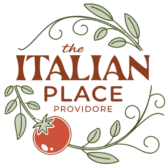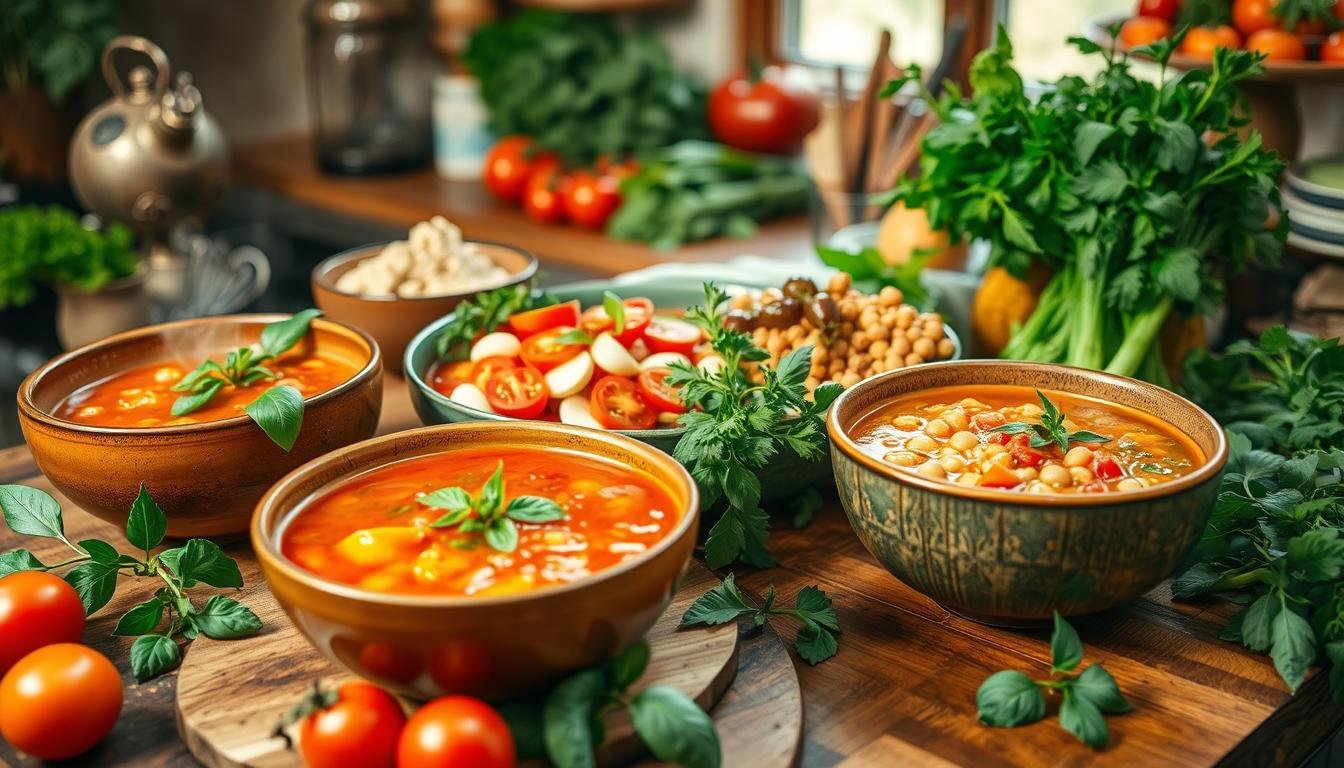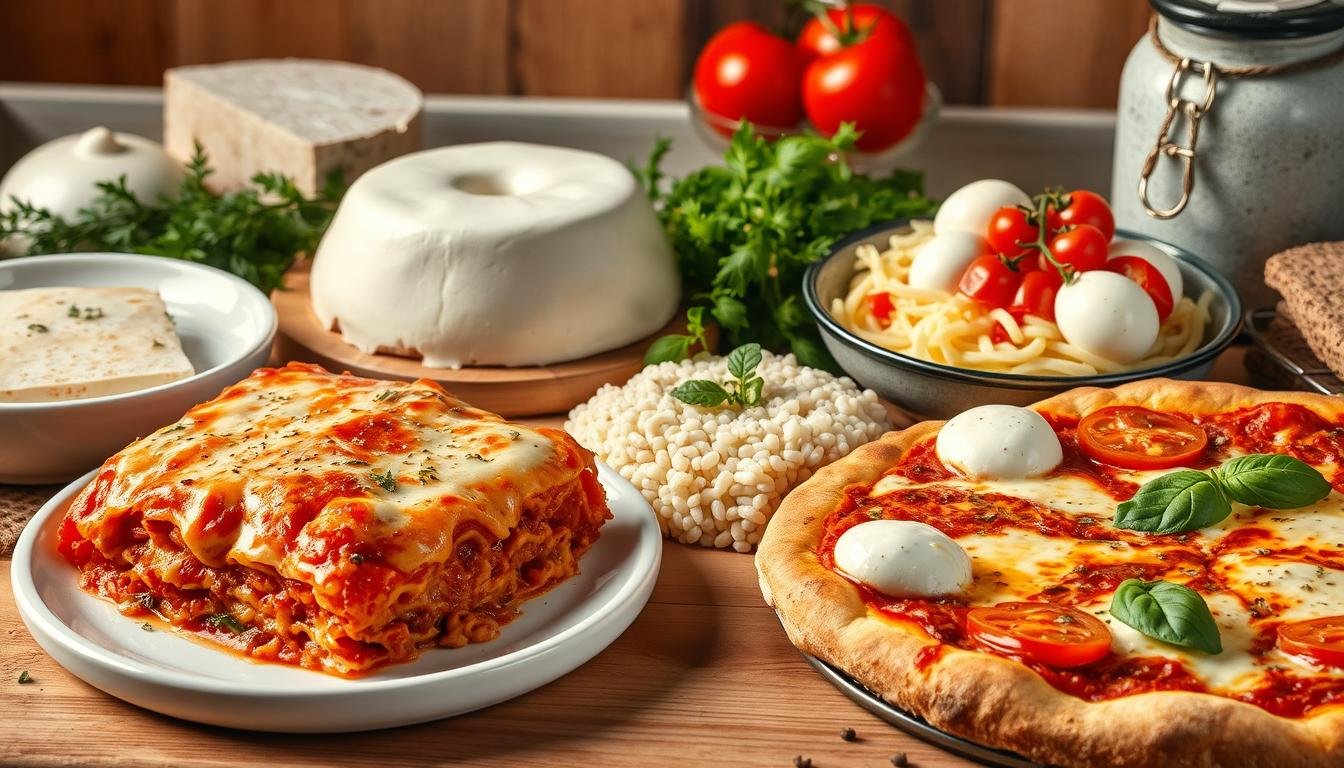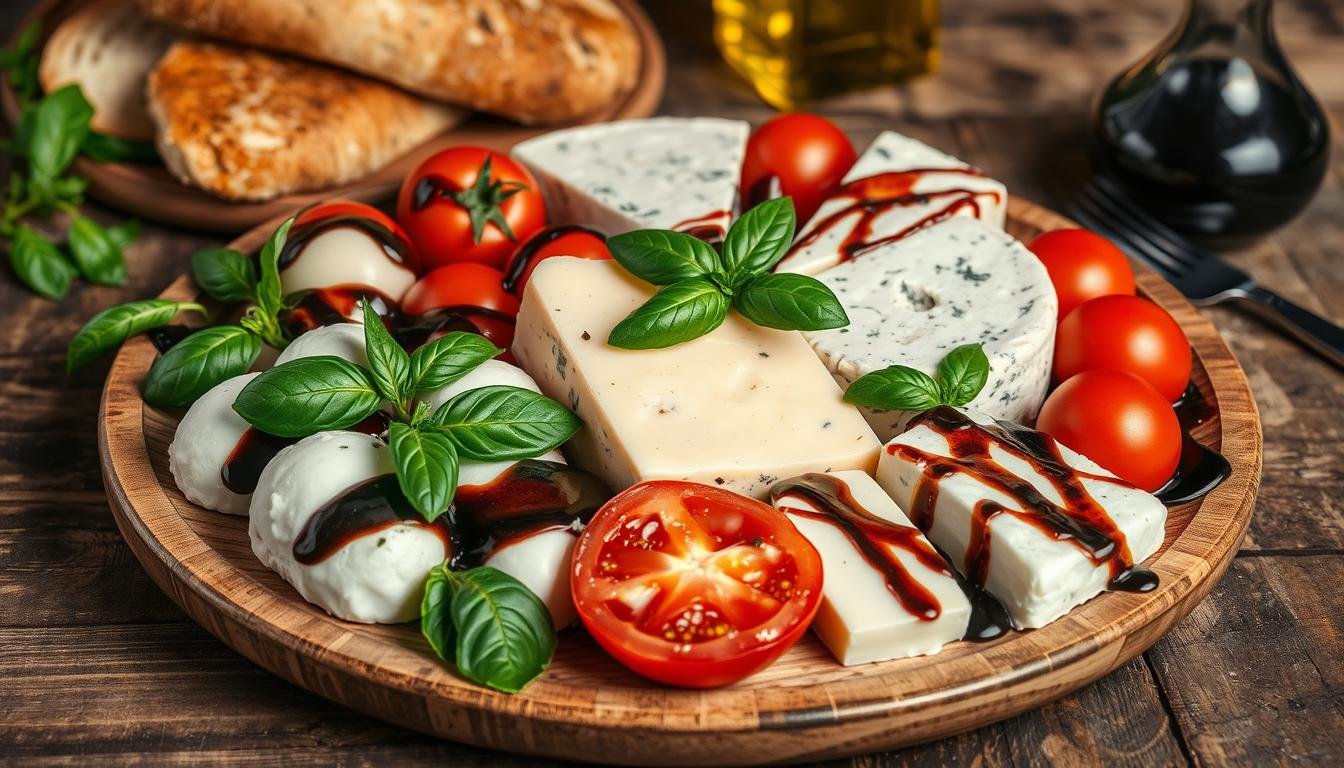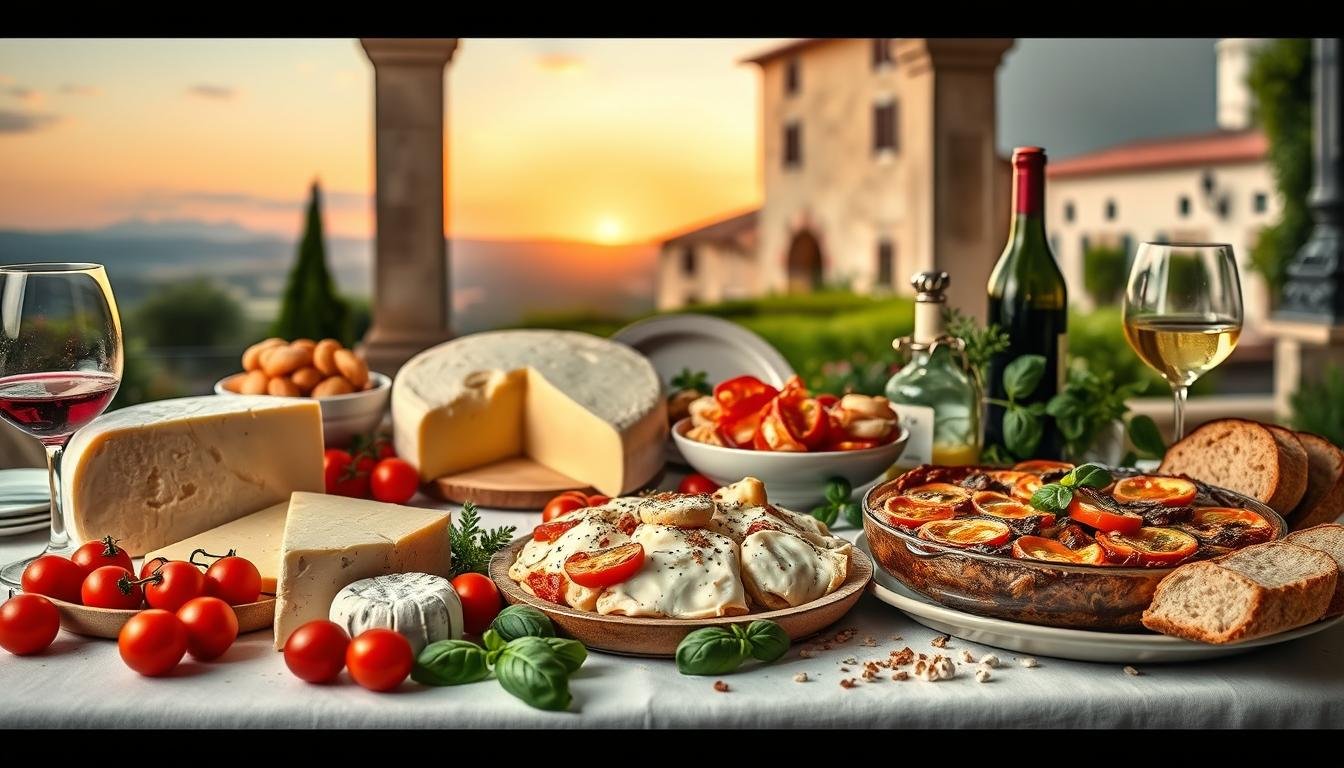Are you ready to explore the vibrant vegetarian cuisine of Italy? We’ll take you on a journey through delicious Italian soups and salads. You’ll discover hearty meatless minestrone and refreshing panzanella. These dishes are full of Mediterranean flavours that are both tasty and healthy.
This guide offers a fresh look at traditional Italian recipes. We show how to make these dishes vegetarian-friendly. We focus on using fresh ingredients and simple cooking methods. This way, you can make authentic Italian food without meat.
Key Takeaways
- Delve into the rich tapestry of Italian vegetarian cuisine, from classic minestrone to inventive bean soups.
- Discover the art of crafting timeless Italian salads, such as the iconic Caprese and the rustic Panzanella.
- Explore the versatility of seasonal Italian soups, from vibrant summer vegetables to comforting autumn and winter warmers.
- Understand the key ingredients and cooking techniques that define the essence of Italian soups and salads.
- Learn about the health benefits of plant-based Italian dishes and how to make substitutions for traditional recipes.
So, are you ready to embark on a culinary adventure that celebrates the vibrant flavours of Italy in a vegetarian-friendly way? Let’s dive in and discover the delights that await!
Introduction to Italian Cuisine
Italy’s food scene is known for its variety and fresh ingredients. Vegetarian Italian cooking uses lots of vegetables, legumes, grains, and herbs. This makes tasty dishes. The Mediterranean climate means there’s plenty of tomatoes, olive oil, and herbs.
The Influence of Regional Ingredients
Italy’s different areas have their own special foods. Southern Italy is known for its tomatoes, while the north is famous for risottos and polenta. Vegetarian cooks can use these ingredients to make real Italian meals.
Flavours of Italy in Vegetarian Cooking
Italian cooking is all about simple, natural tastes. Vegetarian Italian cooking keeps this spirit alive. It highlights the sweetness of veggies, the smell of herbs, and the taste of olive oil. You can find these flavours in everything from pasta to salads.
Chef Michael Chiarello says Italian meals often focus on what’s in season. This makes it easy for vegetarians to join in. Many Italian dishes, like Caponata, Orecchiette con cime di rapa, and La ribollita, are already vegan or can be made vegetarian.
“Italian cuisine emphasizes produce with protein being a secondary element,” – Chef Michael Chiarello
Vegetarian cooks can make delicious, healthy dishes by using Italy’s rich ingredients and flavours. This way, they can truly enjoy the Mediterranean way of eating.
Popular Italian Soups for Vegetarians
Italian vegetarian soups are full of flavour and texture. You can enjoy the hearty Meatless Minestrone or the light Stracciatella. These Vegetable Broth Soups show how versatile Italian vegetarian cooking can be.
Minestrone: A Hearty Vegetable Delight
Minestrone is a classic Italian vegetable soup. It’s made with seasonal produce and pantry staples. This Meatless Minestrone is full of fresh vegetables, beans, and small pasta. It’s a satisfying meal that’s ready in 30-60 minutes, perfect for busy nights.
Stracciatella: Italian Egg Drop Soup
Stracciatella is a lighter option, similar to egg drop soup. It’s a Vegetable Broth Soup with a flavorful broth and whisked eggs. This creates a delicate and satisfying texture.
Bean Soups: From Pasta e Fagioli to Fagioli in Umido
Legumes are the stars in many Italian vegetarian soups. The classic Pasta e Fagioli and the rustic Tuscan Bean Soup, or Fagioli in Umido, are great examples. These Vegetable Broth Soups mix protein-rich beans with pasta or vegetables. They offer a filling and nutritious meal.
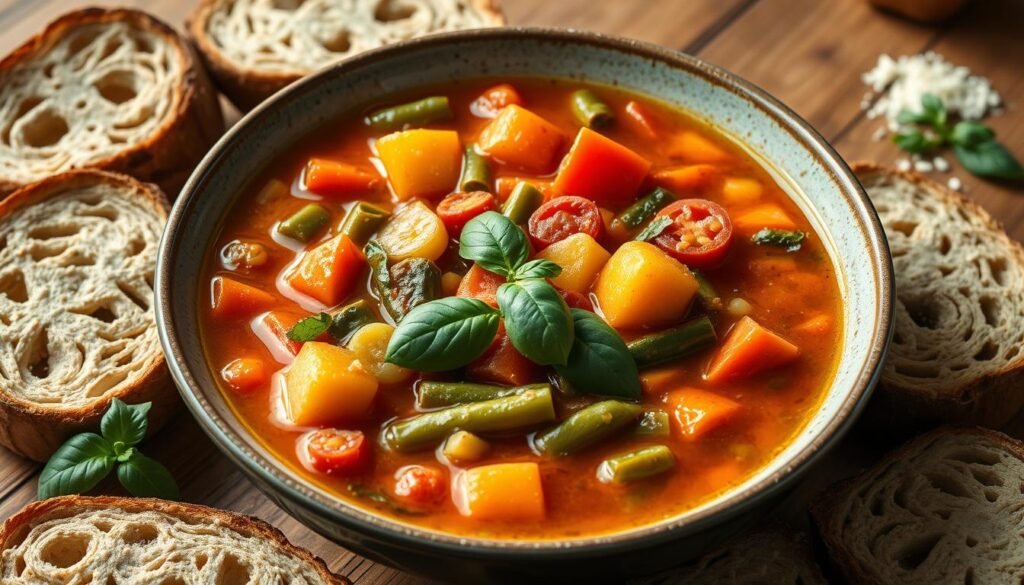
These Italian vegetarian soups can be easily adapted to use the season’s best produce or to fit your taste. Whether you prefer a Meatless Minestrone, a light Stracciatella, or a comforting Tuscan Bean Soup, Italian flavours will surely please your taste buds.
Classic Italian Salads
Italian cuisine is famous for its vibrant salads. These dishes highlight the beauty of fresh ingredients. Classics like Caprese and Panzanella show off Italy’s natural produce.
Caprese Salad: A Timeless Combination
The Caprese salad is a classic Italian dish. It combines ripe tomatoes, creamy mozzarella, and fragrant basil. A drizzle of olive oil and balsamic vinegar brings out the flavours.
Variations of the Caprese salad include different tomatoes. You might also find avocado or prosciutto added for a twist.
Panzanella: Tuscan Bread Salad
Panzanella is a Tuscan bread salad that turns stale bread into a tasty dish. It’s soaked in a tangy dressing with olive oil, vinegar, and seasonings. Then, it’s mixed with juicy tomatoes, crisp cucumbers, and other fresh veggies.
This salad shows Italian cooks’ creativity with leftovers. It’s a celebration of resourcefulness.
Insalata mista: The Simple Green Salad
The insalata mista, or mixed green salad, is a staple in Italian cuisine. It features a variety of greens like lettuces and arugula. A light vinaigrette dressing makes it refreshing.
This salad is perfect with many Italian meals. It highlights the quality of the greens.
These classic Italian salads showcase the country’s love for fresh ingredients. Whether you’re in a piazza or at home, they bring a taste of Italy to you.
Seasonal Italian Soups
Italian cuisine loves to use fresh ingredients all year round. This is clear in their tasty soups. Summer soups are light and cool, while winter soups are warm and comforting. These soups show off Italy’s cooking skills.
Summer Vegetable Soups
In summer, Italian kitchens make soups with fresh summer veggies. Tomatoes, zucchini, and herbs make these soups bright and tasty. These Summer Vegetable Recipes are perfect for eating outside.
Autumn Harvesting: Pumpkin and Squash Soups
Autumn brings cooler weather and a harvest of pumpkins and squash. These Seasonal Vegetable Soups are smooth and comforting. The earthy tastes of autumn veggies pair well with warm spices.
Winter Warmers: Ribollita and Other Comfort Soups
In winter, Italians enjoy thick, warming soups. Italian Winter Soups like Ribollita are full of veggies and beans. These soups are great for warming up and enjoying the season’s food.
Italian soups change with the seasons, showing their love for fresh ingredients. Whether you want something light or hearty, Italian soups have it all.
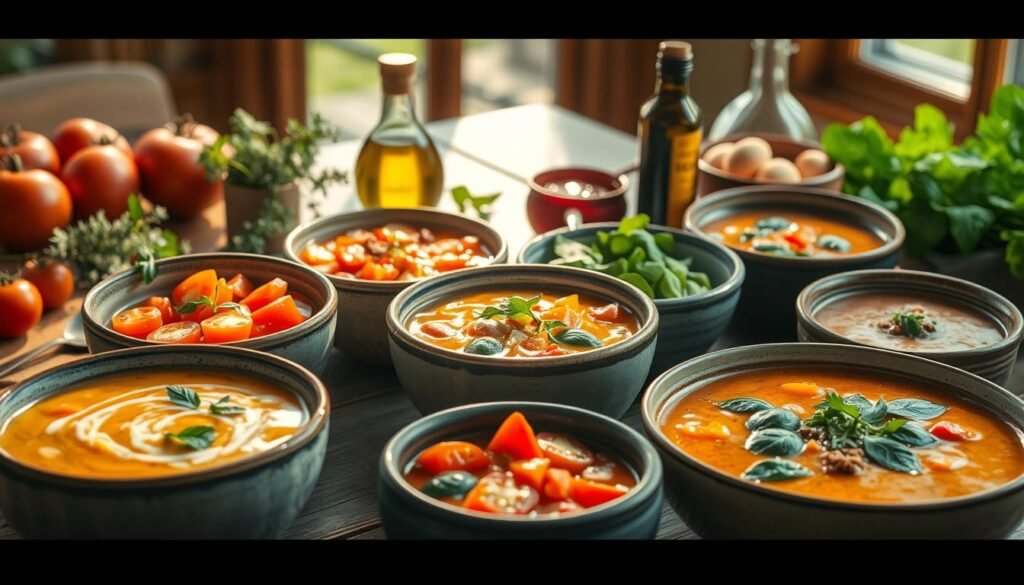
Key Ingredients in Italian Soups
Italian vegetarian soups are made special by the ingredients used. Fresh herbs and seasonal produce are key. They create the rich, comforting flavours we love.
Fresh Herbs: Basil, Oregano, and More
Fresh herbs add depth and aroma to Italian soups. Basil brings a sweet, peppery taste. Oregano adds an earthy, minty flavour. Parsley brightens the soup with its grassy notes.
Seasonal Vegetables: What’s in Season?
Seasonal produce is the base of many Italian soups. Summer brings fresh tomatoes, zucchini, and eggplant. Autumn offers pumpkin and squash. Winter adds kale, cabbage, and root vegetables for heartiness.
Pasta and Grains: A Sustaining Touch
Pasta or grains make Italian soups satisfying. Small shapes like ditalini or orzo add comfort. Whole grains like farro or barley bring texture and flavour. They make the soup filling and nutritious.
| Ingredient | Quantity | Nutrition Facts |
|---|---|---|
| Lentils | 1 cup | 267 calories, 35g carbs, 14g protein, 8g fat, 16g fiber |
| Italian Vegetable and Bean Soup | 1-1.5 cups | 272 calories, 49g carbs, 14g protein, 3g fat |
Italian cooks mix these ingredients to make nourishing soups. The Italian Herb Seasonings, Seasonal Vegetable Guide, and Pasta in Vegetarian Soups combine for a delicious experience. Italian soups are a true favourite.
Distinctive Features of Italian Salads
Italian salads are all about freshness and quality. They don’t need complex preparations. Instead, they let the natural flavours of the ingredients shine.
Freshness Over Processed: An Italian Approach
In Italy, salads celebrate the deliciousness of fresh Italian salad ingredients. They use crisp lettuce, juicy tomatoes, crunchy vegetables, and fragrant herbs. Each ingredient is chosen carefully to blend well in taste and texture.
Dressings: Olive Oil, Vinegar, and Beyond
The Italian salad dressings are simple. They use extra virgin olive oil in salads and various vinegars. Balsamic vinegar, lemon juice, and fresh herbs add complexity, but they don’t overpower the main ingredients.
“The true essence of Italian salads lies in their commitment to showcasing the inherent beauty and taste of their ingredients.”
Italian salads focus on freshness and simple dressings. This lets diners enjoy the pure flavours of the Mediterranean. It’s a delightful experience that also supports the health benefits of a plant-based diet.
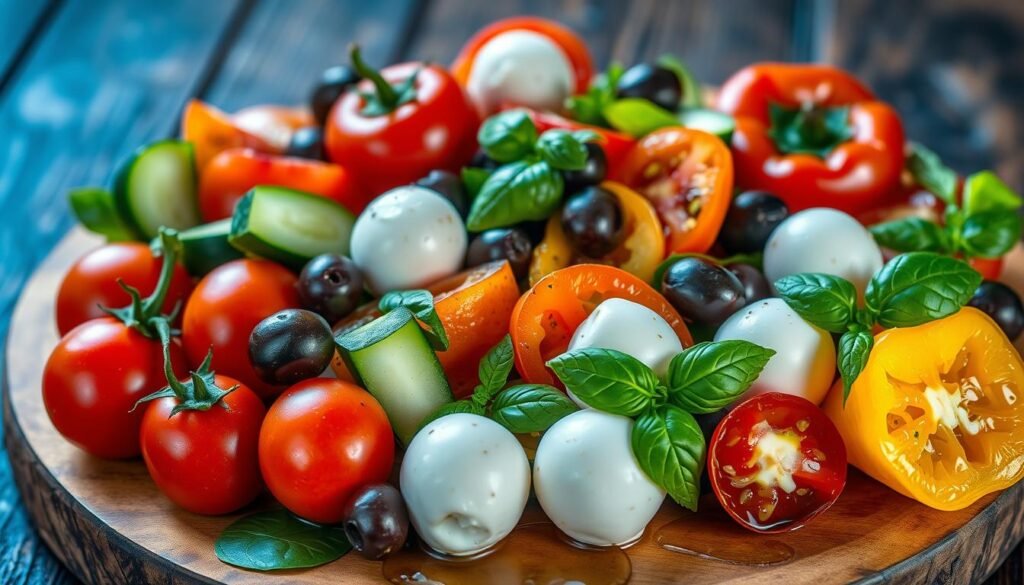
Pairing Soups and Salads
Pairing soups and salads is a great way to make a balanced vegetarian Italian meal. This combination creates a delicious and healthy dining experience. It’s all about finding the right balance of flavours and textures.
Complementary Flavours: Balancing Ingredients
For a perfect pairing, match light salads with hearty soups. Or, pair creamy soups with bigger salads. This mix of contrasts makes the meal both tasty and beautiful to look at.
Sides and Bread: Perfect Pairings
No Italian meal is complete without fresh, crusty bread. Whether it’s a classic Italian loaf or golden focaccia, it’s perfect with soups and salads. Use the bread to soak up soup broth or as a base for salads.
By pairing Italian soups and salads thoughtfully, you can make a meal that’s both tasty and healthy. Adding the right bread makes it a complete and satisfying experience. It celebrates the vibrant flavours of Italian cuisine.
| Soup and Salad Pairings | Bread Recommendations |
|---|---|
|
|
These combinations of Italian soups and salads with the right bread make a balanced meal. It’s sure to please your taste buds and nourish your body.
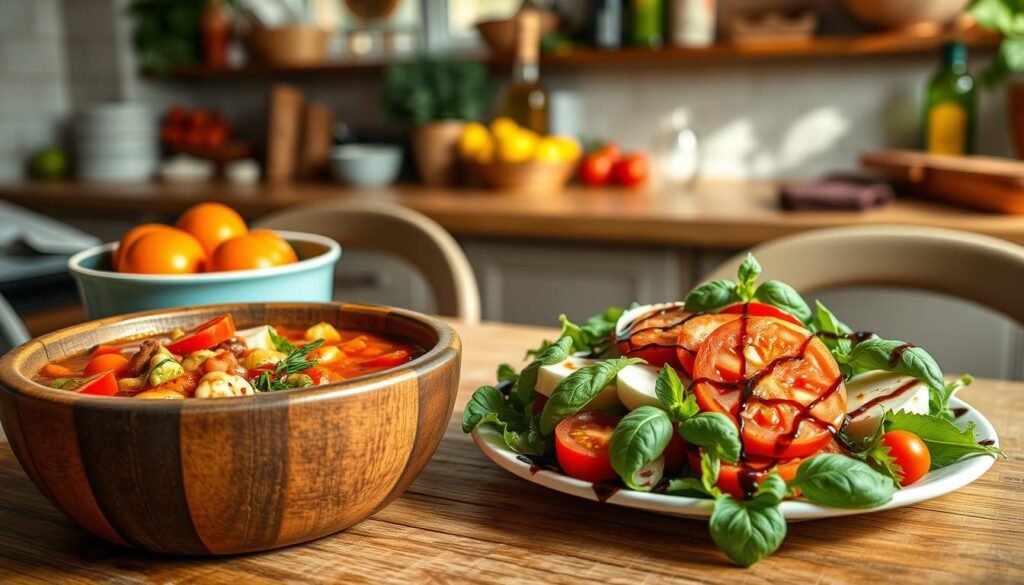
Health Benefits of Vegetarian Italian Dishes
Italian soups and salads are great for vegetarians. They are full of fibre, vitamins, and minerals. This is because they use lots of fresh veggies, legumes, and herbs. The use of olive oil also adds heart-healthy fats, which can lower disease risks.
Nutritional Advantages of Plant-Based Ingredients
Italian vegetarian dishes follow the healthy Mediterranean diet. This diet is known for reducing heart disease, diabetes, and cancer risks. It’s packed with fresh produce, whole grains, and plant proteins. Italian vegetarian soups and salads are full of nutrients like:
- Dietary fibre for better digestion and feeling full
- Antioxidants and phytochemicals from colourful veggies and herbs
- Heart-healthy fats from extra-virgin olive oil
- Plant-based proteins like beans, lentils, and whole grains
- Vitamins and minerals for overall health
Italian Herbs and Their Health Benefits
Italian cuisine’s flavours come from fresh herbs like basil, oregano, and rosemary. These herbs add flavour and health benefits to vegetarian dishes:
| Herb | Health Properties |
|---|---|
| Basil | High in antioxidants, anti-inflammatory, and brain health support |
| Oregano | Rich in antimicrobial and antioxidant compounds, supports immune health |
| Rosemary | Contains anti-inflammatory and neuroprotective compounds, good for brain function |
Adding these herbs to vegetarian Italian dishes brings together great taste and health benefits.
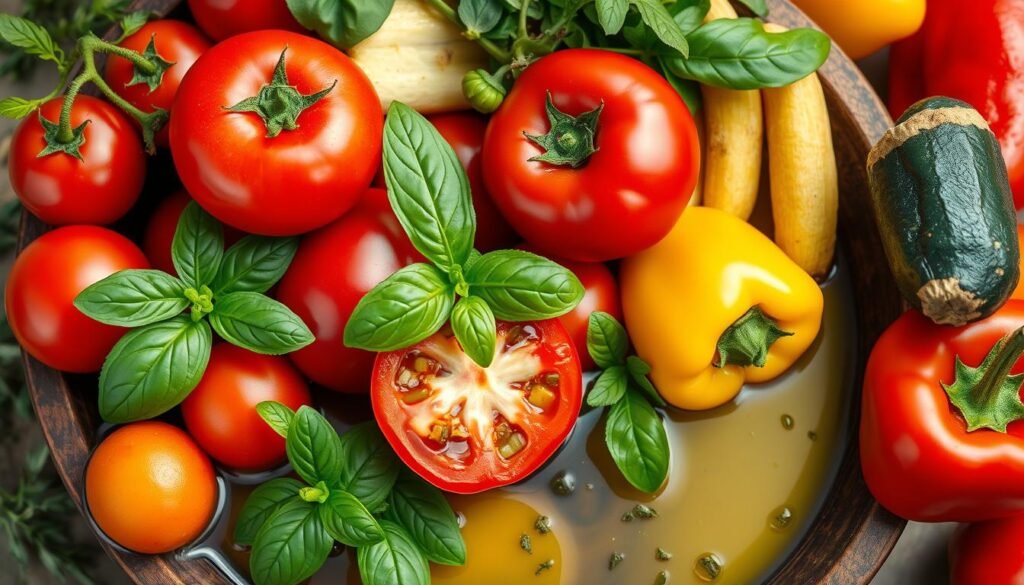
“Eating a plant-based, Mediterranean-style diet is one of the healthiest ways to nourish your body and reduce the risk of chronic diseases.”
Vegetarian Substitutes in Traditional Recipes
Italian food is famous for its deep flavours and warm dishes. But, many classic recipes can be made vegetarian or vegan. By swapping ingredients, we can keep the taste of Italy while eating plant-based.
Cheese Alternatives in Soups and Salads
Finding dairy-free options for cheese can be tricky. Yet, there are many plant-based choices that work well in soups and salads. Nutritional yeast gives a cheesy taste to soups like Minestrone. Creamy cashew “cheese” is great for Caprese salads or Panzanella.
Using Plant-Based Proteins Effectively
Lentils, chickpeas, and tofu are great for Vegan Italian Recipes. They can replace meat in dishes like Pasta e Fagioli or Ribollita. This adds texture and nutrition. Trying different Dairy-Free Italian Dishes lets vegetarians enjoy Italy’s bold tastes while eating plant-based.
| Vegan Italian Dish | Plant-Based Protein Substitute |
|---|---|
| Pasta alla Norma | Grilled or roasted eggplant |
| Lentil Bolognese | Brown lentils |
| Tofu Cacciatore | Firm or extra-firm tofu |
| Seitan Steaks | Seitan (wheat gluten) |
Using Plant-Based Protein Sources and Dairy-Free Italian Dishes lets us enjoy Italy’s rich flavours. We can do this while sticking to a vegetarian or vegan diet.
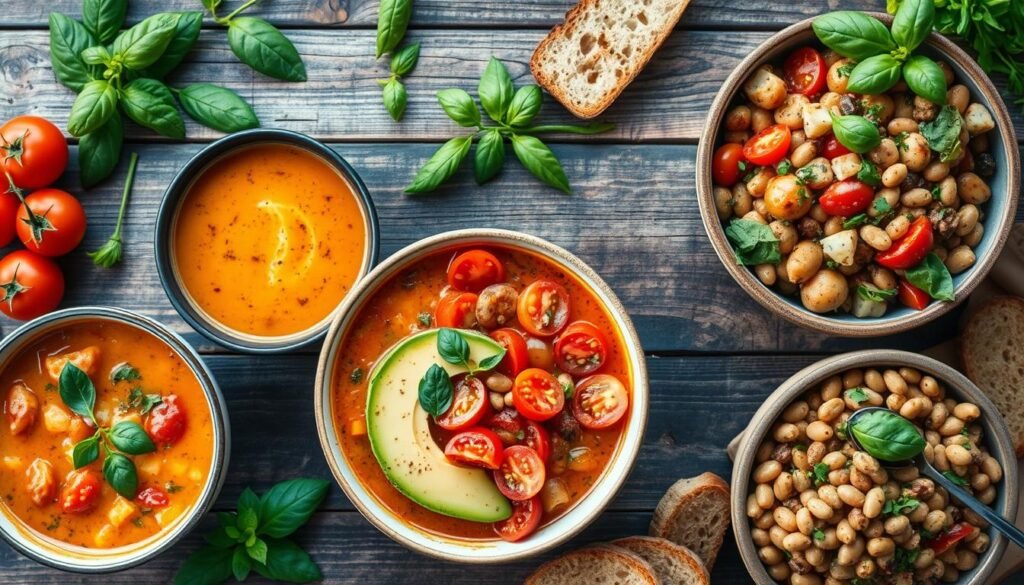
Cooking Techniques for Italian Soups and Salads
Making authentic Italian soups and salads needs careful attention to cooking methods. Italian Cooking Methods show the difference between simmering and boiling. Soups do well with slow simmering, letting flavours blend over time. Quick boiling can lose the delicate tastes and textures.
Simmering vs. Boiling: Best Practices
For Soup Simmering Techniques, aim for a temperature just below boiling, around 95°C (205°F). This gentle heat brings out the full flavours, making a nourishing broth. A hard boil can make veggies mushy and lose their colour.
Chilling Salads for Optimal Flavour
Chilling ingredients is key for Salad Preparation Tips. Letting the salad chill in the fridge for 30 minutes before serving enhances flavours and crispness. This simple step can turn a simple salad into a refreshing delight.
Proper cutting is also important for even cooking and a nice look. Uniform slices or dices ensure all ingredients cook perfectly, without any being over- or undercooked.
Learning these Italian Cooking Methods, Soup Simmering Techniques, and Salad Preparation Tips lets home cooks bring Italy’s true flavours to their dishes. They’ll make meals that impress everyone.
Serving Suggestions and Presentation
In Italian cuisine, how you present your soups and salads is key. You want your dishes to taste great and look good too. There are many ways to make your soup and salad plating stand out, from Italian food presentation to traditional serving methods.
Eye-Catching Plating Techniques
Think about the colours and textures of your ingredients. Arrange your salads in a way that catches the eye. Use fresh vegetables and herbs to add vibrant hues. A drizzle of balsamic glaze or lemony dressing can make it shine.
For soups, try garnishes like basil pesto, Parmesan, or lemon juice. These add freshness and a touch of elegance.
Traditional Italian Serving Styles
In Italy, soups and salads are often served family-style. You can use a large platter or individual bowls. This encourages everyone to share and enjoy together.
For a more formal setting, serve each dish in a neat, garnished bowl. This highlights the beauty of your creations.
Whether it’s family-style or individual servings, focus on the colours, textures, and flavours. By paying attention to presentation and using traditional serving methods, you’ll create a memorable dining experience. It will celebrate the heart of Italian cuisine.
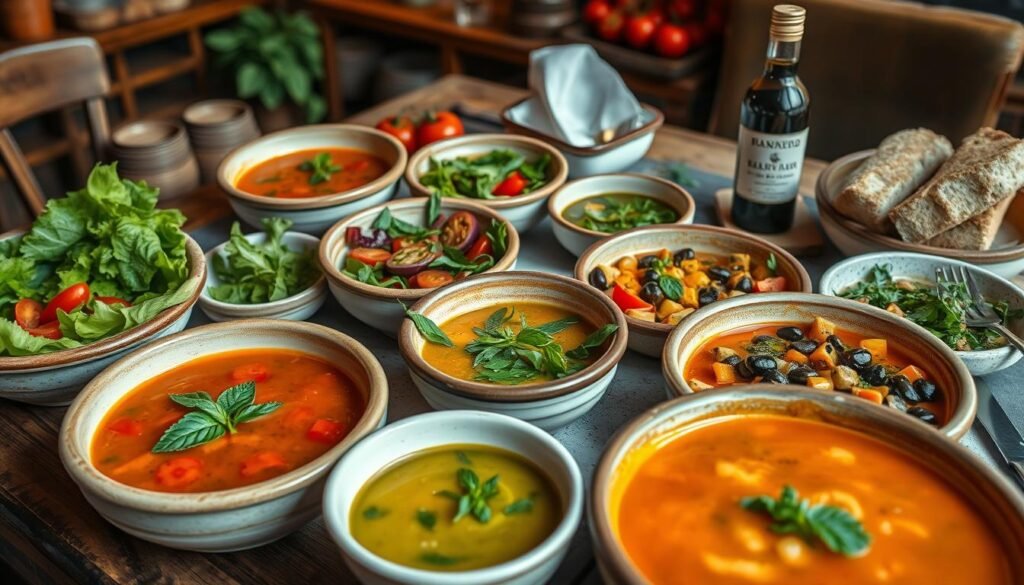
Conclusion: Why Choose Italian Soups and Salads?
Italian soups and salads are a great way to start with vegetarian food. They use fresh ingredients and simple recipes. This lets the natural tastes of the food come through.
From the warm Minestrone to the cool Caprese Salad, these dishes are both tasty and healthy. They show how good plant-based food can be.
Emphasis on Fresh Ingredients and Simplicity
Italian soups and salads are all about keeping things simple. They use the best, freshest ingredients available. This makes every bite full of flavour.
For example, a Panzanella salad uses ripe tomatoes and fresh basil. These ingredients are chosen for their taste and quality. This approach is perfect for those who love good, honest food.
Encouraging Exploration in Vegetarian Cuisine
Trying Italian vegetarian soups and salads is a fun adventure. They open the door to a world of tasty, meat-free dishes. You can try new recipes and flavours.
Exploring Italian vegetarian food can also make you appreciate the creativity of plant-based cooking. It’s a chance to discover new tastes and recipes.
